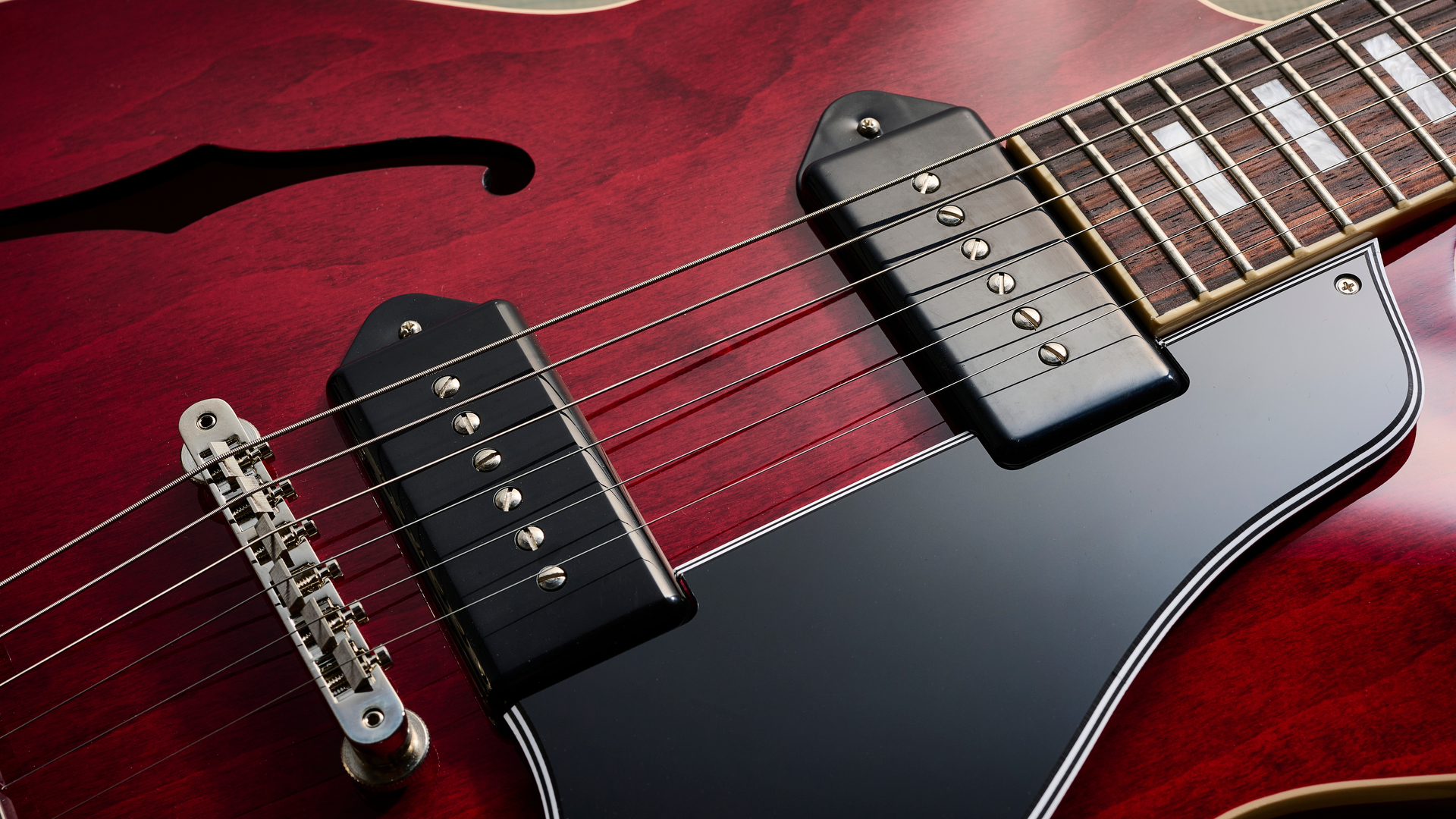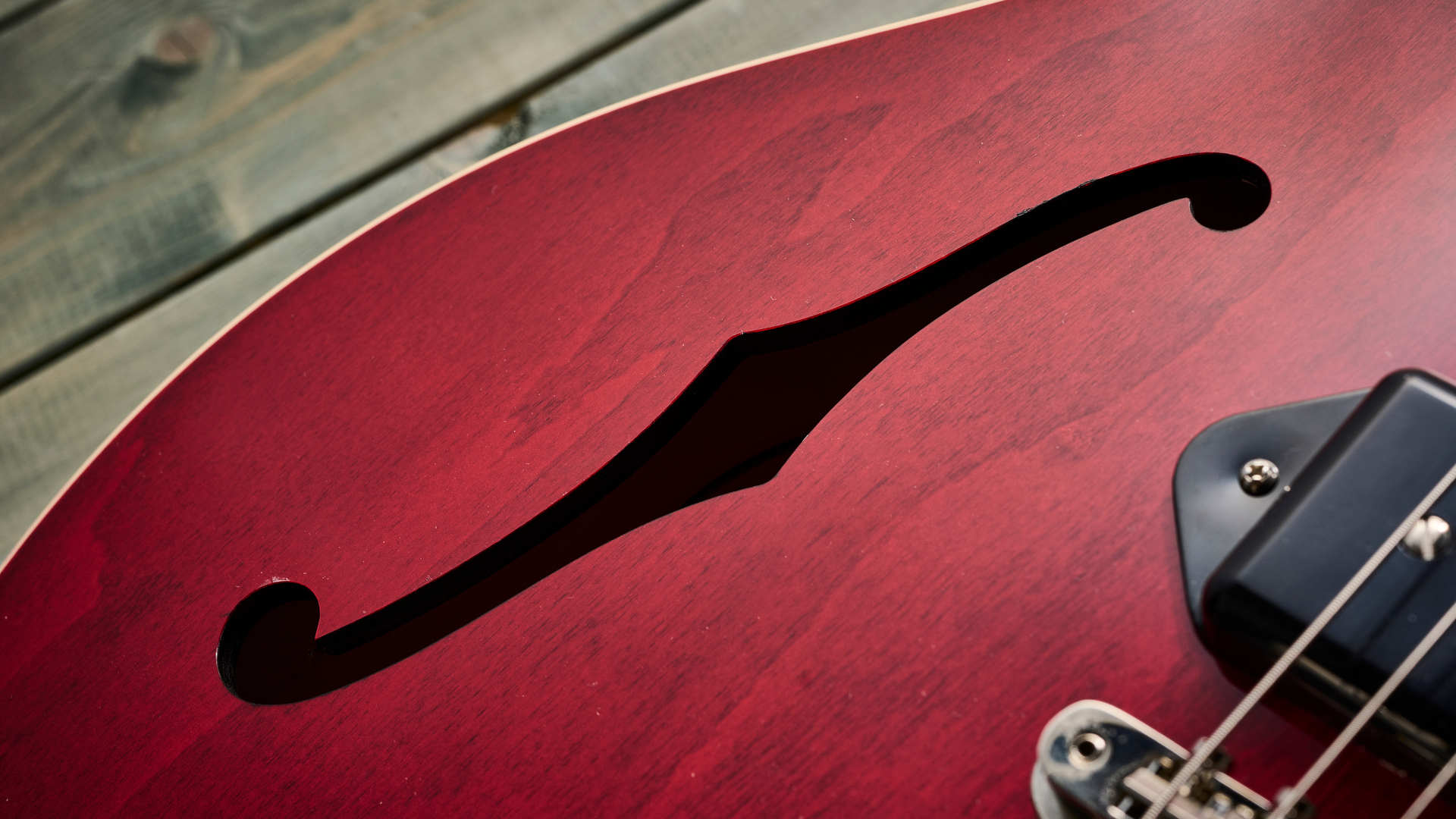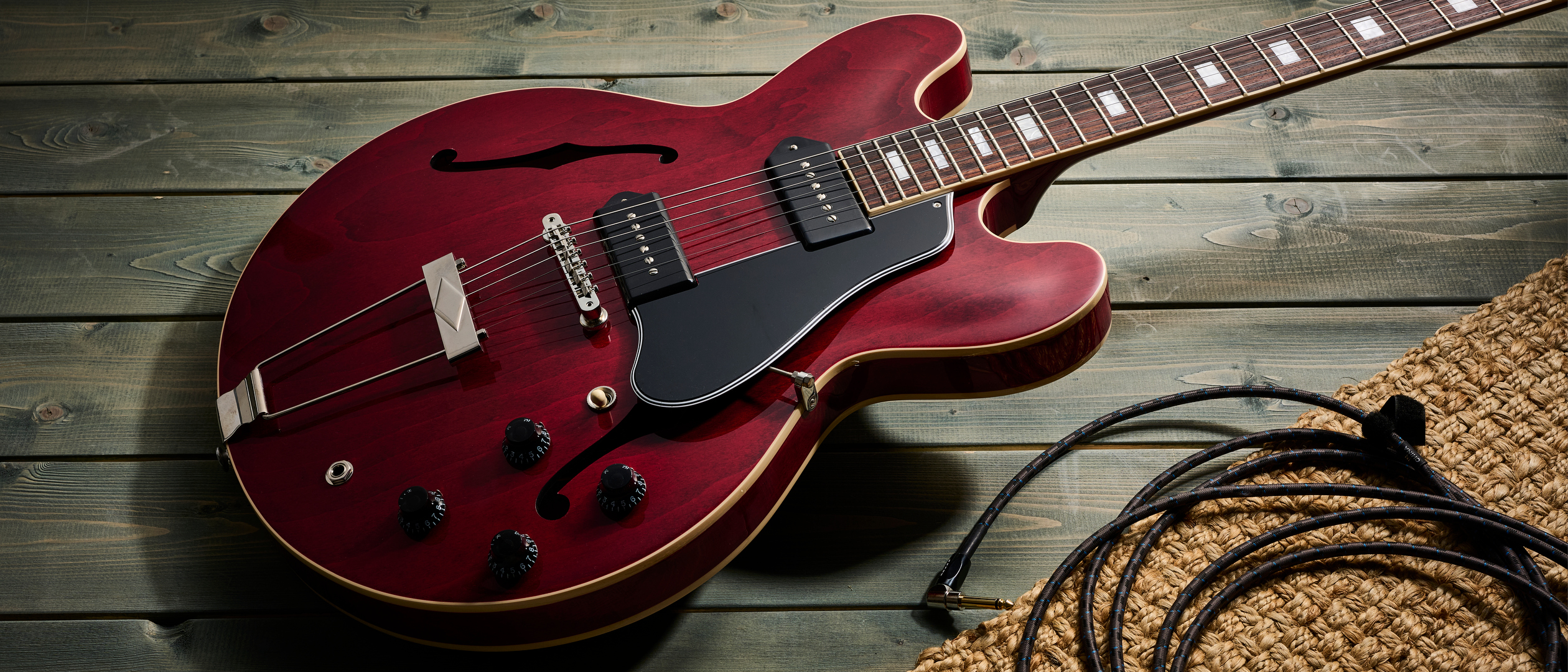MusicRadar Verdict
It’ll cover everything bar heavy rock and metal, with ultra-cool looks, unrivalled credentials, top sounds and playability.
Pros
- +
Great looks and vintage heritage.
- +
Brilliant tones and fine playability.
- +
Light weight and great feeling neck.
Cons
- -
Limited access to top-end frets.
- -
Will give feedback howl at very high volumes.
MusicRadar's got your back
What is it?
In recent times, Epiphone reissued its impressive US-made E-230 Epiphone Casino making it inevitable that Gibson would follow up with its own branded version of the same guitar. That time is now, with the return of the ES-330.
Never Gibson’s most popular thinline, perhaps this time its charms will be better appreciated than back in those blues-rock heydays.
What compromised the ES-330’s popularity was that, due to it being a fully hollow construction, with no centre block as in the ES-335, it was a feedback nightmare through big, loud amplifiers. And since its neck sat further into the body than its semi-solid sister model, top-fret forays were off the agenda.
But with today’s move towards smaller guitar amps, and less of a desire for dusty end widdle-fests, these woes pale against the instrument’s super light weight, ultra comfy neck, effortless playability, and super cool vibe.

Specs

Launch price: $3,499 / £3,099/ €3,599
Made: USA
Type: Double-cutaway, hollowbody electric
Body: Fully hollow, cream bound maple/poplar/maple laminate top, back and sides
Neck: Mahogany, ‘rounded C’
Fingerboard: Bound Indian rosewood with small pearloid block markers; 304mm/12” radius
Scale length: 629 mm/24.75”
Nut/width: GraphTech (43.053mm/1.695")
Frets: 22, medium jumbo
Hardware: Vintage Deluxe tuners with white buttons, ABR-1 bridge with Trapeze tailpiece
String spacing at bridge: 51.56mm
Electrics: Dog-ear P90 neck and bridge single coils, twin 500K volume and tone pots, orange drop capacitors
Weight: 2.75.6.0627
Options: Gibson ES-335 (£3,399), centre block body with 19th fret neck join, dot inlaid rosewood fingerboard, twin humbuckers; Gibson ES-345 (£3,499), as above but with double parallelogram markers, gold plated parts and multiple body binding
Left-handed options: N/A
Finishes: Sixties Cherry (as reviewed), Tobacco Sunburst, Antique Natural, Ebony (online only)
Case: Tan, pink-lined case
Contact: Gibson
Build quality

Build quality rating: ★★★★★
Looking the guitar over reveals a beautifully built instrument in the period correct shade of see-through cherry red, the thin skin nitro lacquer expertly applied and buffed to a perfect gloss.
The body’s arched top and back are a maple-poplar-maple laminate pressed into shape, with internal spruce bracing supporting the top. A one-piece mahogany neck is topped off by a block-inlaid rosewood fingerboard with 22 medium jumbo frets.
Gibson sculpts the neck binding to create ‘nibs’ that cover the fret ends; when done well, as here, it’s a sophisticated solution to the age-old problem of sharp tips snagging the fingers or catching the strings.

The black plasticware looks classy, offset as it is by cream binding all round save for the headstock. Hardware comprises white-button classic Kluson-style tuners, nickel-plated tune-o-matic bridge, diamond embossed trapeze tailpiece, and slightly larger than vintage style aluminium strap buttons.
Electrics-wise we get a pair of Gibson dog-ear P90 pickups mated to twin volume and tone controls with black top hat knobs, 500K pots and orange drop capacitors. Other finish options include Tobacco Sunburst and Antique Natural, as well as an online only, ‘Gibson Exclusive’ Ebony version.
Playability

Playability rating: ★★★★☆
Strapping on the ES-330 reveals why it was a favourite (along with its sister the Epiphone Casino) with rhythm players, or those who majored on riffy, rock’n’roll style soloing.
With the neck being three frets further into the body, open chords are easy to reach, while barre shapes are a doddle up to the 12th fret. The guitar’s ultra-light weight makes it supremely comfortable, too, especially when worn a little higher on the strap.

With its rounded C profile the neck is supremely comfortable, and the 10-gauge strings fitted are slack and bendy.
Where some guitars feel hard and uninviting to play this one lets you right in, to the point where you almost feel at one with the thing.
No, you can’t blaze pentatonics at the 17th fret, but virtually anything else you want to do is here at your fingertips.
Sounds

Sounds rating: ★★★★★
Plugging into a Boogie MkI reissue combo reveals a versatile set of tones that would suit almost any genre of popular music. Jazz, blues, pop or light to medium rock are all dutifully served.
Even when played clean, P90s have a slight rasp that makes for an organic tone that, when turned right down to 2 or 3, can sound almost acoustic in nature. And with the amp set to a healthy dose of drive one can go from clean to gnarly with no more than a twist of a control.
With the neck pickup on about 6 and some tone rolled off we go from straight jazz, to vintage blues with both knobs cranked a notch or two. And flipping to the bridge pickup on about 8 with the tone all but full up, is rock’n’roll heaven. Given that both BB King and Chuck Berry had ES-330 phases this should come as no surprise.

Think Satisfaction, It’s All Over Now, Paperback Writer, Get Back, All Day And All Of The Night and many, many more
Both P90s on is a fabulous choice, as balancing the controls provides an immense array of sounds. Of course, such is the model and its Epiphone E-230 cousin’s association with ’sixties British beat music that all manner of Stones, Beatles and Kinks tones are on tap, too. So think Satisfaction, It’s All Over Now, Paperback Writer, Get Back, All Day And All Of The Night and many, many more.
As an exercise we cranked the Boogie to gigging volume and the ES-330 didn’t feed-back unless the guitar was pushed pretty close to the speaker. So pair one with a Deluxe Reverb, Vox AC15, Boss Katana or similar, and you’ll encounter no problems at all.
Verdict

We love it when Gibson gets it right, given how we’ve criticised quality control over the years. And boy has it hit bullseye here. The ES-330 deserves another shot at the spotlight, and we hope it might get a better bite of the cherry (sic!) this time round.
We love it when Gibson gets it right, given how we’ve criticised quality control over the years. And boy has it hit bullseye here
It’s just such a usable instrument. It plays like butter, is extremely well made and set up, and is packed with a fabulous range of recognisable tones.
True, flat-out through a 100-watt Marshall stack is not particularly feasible with an all-hollow guitar, and Gary Moore style top-fret flailing is out of the question. But open your mind and heart to this delightful instrument and you’ll discover a faithful musical pal for almost any occasion.
MusicRadar verdict: It’ll cover everything bar heavy rock and metal, with ultra-cool looks, unrivalled credentials, top sounds and playability.
| Test | Results | Score |
|---|---|---|
| Build quality | Gibson really nails the build on this one. Everything is in its right place. | ★★★★★ |
| Playability | It's great fun to play but the upper-fret access on a 330 is always compromised. | ★★★★☆ |
| Sounds | Feedback at high volumes is part of the charm with a guitar that has a positively iconic voice. | ★★★★★ |
| Overall | A thoroughly welcome return for Gibson's "Casino" that is no gamble for any player looking for a classic hollowbody. | ★★★★1/2 |
: Also try

($1,699/£979
Eastman offers exceptional semi-hollow guitars at relatively affordable prices. The Romeo LA comes equipped with foil-style P90s and a roller vibrato to boot.
Read our review

$3,499/£3,199
Yep, that's right. A US-made Epiphone. The Epiphone Casino was the some-time guitar of choice for The Beatles, The Kinks and The Rolling Stones to name a few. Here, it's back with a trapeze tailpiece in a choice of Vintage Sunburst or Royal Tan.

$3,999/£3,399
The quintessential semi-hollow guitar. The ES-335 offers a feedback-fighting centre-block as well as humbuckers in place of the P90 pickups. in this case, you get T-Types in both positions.
Hands-on videos
Alamo Music Center
Cream City Music
“This update reflects everything we believe modern gear should be”: Neural DSP gives the Nano Cortex an almighty power-up with free NanOS 2.0.0 system update
“It’s honestly got me thinking hard about adding one to my own studio set up”: Two Notes Reload II review
“Gloriously adorned with a gold edge burst finish over a gold paisley and sparkle top”: Gretsch unveils the Paisley Penguin – a rare bird that growls – and the Honey Dipper Special, a resonator for all your roots rock manoeuvres












